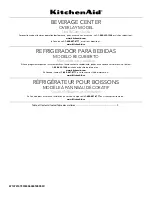
INTRODUCTION
Congratulations on your decision to purchase a Hague Series 96 water
treatment appliance. Recognized internationally for built-in quality,
dependability, and ease of service, this appliance represents the state-of-the-art
in home water treatment.
While your appliance should be installed and serviced by a professional
Hague dealer, important information is contained in this manual which will
help you get the maximum benefit and enjoyment from your Series 96.
We urge you to read this information carefully and review it again at any time
you notice a change in your water or appliance. Later in the manual is a
Troubleshooting section. If you are unable to fix a problem simply, please call
your Hague dealer for expert service.
How the Series 96
Works
Rain water is naturally soft. As water travels through the ground, it dissolves
some of the rocks and minerals it touches. When the dissolved minerals are
calcium and magnesium, the water is said to be hard. Hard water often also
contains traces of dissolved iron, dirt, and sediment particles. Although hard
water is not harmful to drink, it can damage your plumbing, appliances and
clothing.
The Series 96 contains a media tank filled with thousands of very small resin
beads. The beads enable the ion exchange process. As hard water flows over
the resin, the beads attract calcium, magnesium, and iron ions. These ions
attach themselves to the beads, pushing sodium ions out of the way.
Depending on your water hardness, after so many gallons have gone through
the softener, the beads are full of hardness and iron and the resin bed is said to
be exhausted. An exhausted resin bed must be cleaned or regenerated. During
regeneration, concentrated salt solution washes over the resin. This time the
beads pick up sodium ions from the salt solution and let go of the hardness
and iron ions, which are washed down the drain. Fresh water rinses the salt
from the resin tank and the water softener is ready to soften water again.
Series 96 Owner’s Manual
1




































